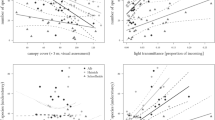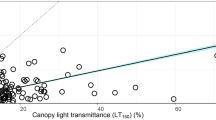Abstract
Seasonal and spatial patterns of light availability were investigated in the understory of a small fragment (approximately 1300 m2) of a riparian deciduous forest of the Kokai River in central Japan dominated byQuercus acutissima Carruth., with the aim to understand the characteristics of microsite light availability forArisaema heterophyllum Blume, a threatened plant species uniquely associated with the riparian habitat. Diffuse site factor, which is the ratio of PFD (photon flux density, 400–700 nm) at a microsite to the open sky reference under diffuse light condition, was shown to be a satisfactory index for the evaluation of light availability for the understory plants in the habitat. Diffuse site factor 1,0 1,000 understory microsites along a 20 m transect from the edge to the interior of the forest, showed conspicuous seasonal changes in both mean and variation. Light availability decreased with seasonal tree canopy regeneration, with the highest spatial heterogeneity being recorded during the time of canopy closure. Auto-correlations of microsite light availability between different seasons were considerably high, suggesting the stability of relative light availability for individual microsites throughout the growing season ofA. heterophyllum. Fairly high light availability during summer season, which surpassed 20% of the open sky reference in most microsites, would be important for the growth and persistence of summer herbaceous plants likeA. heterophyllum.
Similar content being viewed by others
References
Anderson, M.C. 1964. Studies of the woodland light climate. II. Seasonal variation in the light climate. J. Ecol.52: 643–663.
Baldocchi, D., Hutchison, B., Matt, D. andMcMillen, R. 1984. Seasonal variations in the radiation regime within an oak-hickory forest. Agric. Forest Meteor.33: 177–191.
Chazdon, R.L. andPearcy, R.W. 1991. The importance of sunflecks for forest understory plants. BioSciences41: 760–766.
EPSG (Endangered Plant Survey Group) 1989. The red data book of Japanese vascular plants. Nature Conservation Society of Japan, Tokyo. (in Japanese).
Horiuchi, T. 1978. Forest areas and their changes around the Lake Kasumigaura. Reports of the studies of environmental sciencesB3-R12-1: 27–35. (in Japanese).
Hutchison, B.A. andMatt, D.R. 1977. The distribution of solar radiation within a deciduous forest. Ecol. Monogr.47: 185–207.
Küppers, M. 1994. Canopy gaps: Competitive light interception and economic space fillihg-A matter of whole-plant allocation.In M.M. Caldwell and R.W. Pearcy, eds., Exploitation of Environmental Heterogeneity by Plants: Ecophysiological process above-and below ground, Academic Press, London., pp. 111–144.
Levenson, J.B. 1981. Woodlots as biogeographic islands in southeastern Wisconsin.In R.L. Burgess and D.M. Sharpe, eds., Forest Island Dynamics in Man-Dominated Landscapes, Springer-Verlag, New York. pp. 13–39.
Okuda, S. 1978. Phytosociological studies of alluvial vegetation in Kanto Plain. Bull. Env. Sci. Center Yokohama National Univ.4: 43–112. (In Japanese with English summary).
Oshima, K. andWashitani, I. 1995. Seasonal changes in light availability of the riparian forests of the KokaiRiver and phenology of understory plant species. Tsukuba Environmental Studies15: 45–51. (In Japanese with English summary).
Pearcy, R.W. 1983. The light environment and growth of C3 and C4 tree species in the understory of a Hawaiian forest. Oecologia (Berlin)58: 19–25.
Salisbury, E. 1976. A note on shade tolerance and vegetative propagation of woodland species. Proc. R. Soc. Lond. B.192: 257–258.
Tang, Y., Washitani, I., Tsuchiya, T. andIwaki, H. 1988. Fluctuation of photosynthetic photon flux density within aMiscanthus sinensis canopy. Ecol. Res.3: 253–266.
Tang, Y., Washitani, I. andIwaki, H. 1992. Effects of microsite light availability on the survival and growth of oak seedlings within a grassland. Bot. Mag. Tokyo105: 281–288.
Washitani, I. andTang, Y. 1991. Microsite variation in light availability and seedling growth ofQuercus serrata in a temperate pine forest. Ecol. Res.6: 305–316.
Author information
Authors and Affiliations
Rights and permissions
About this article
Cite this article
Oshima, K., Tang, Y. & Washitani, I. Spatial and seasonal patterns of microsite light availability in a remnant fragment of deciduous riparian forest and their implication in the conservation ofArisaema heterophyllum, a threatened plant species. J. Plant Res. 110, 321–327 (1997). https://doi.org/10.1007/BF02524930
Received:
Accepted:
Issue Date:
DOI: https://doi.org/10.1007/BF02524930




